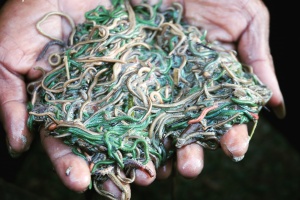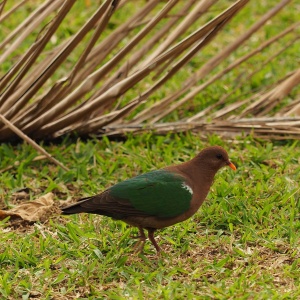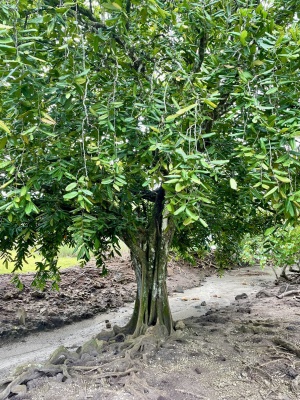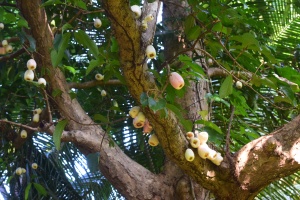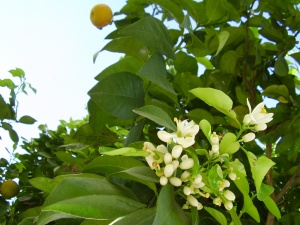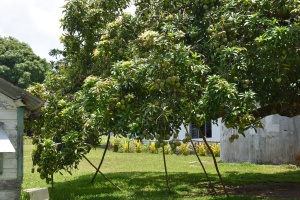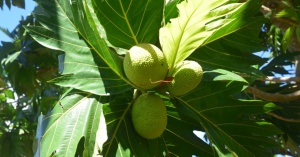Jen Sutfin
Palolo Worm
Palola viridis
Palolo are found in tropical regions of Asia and the Pacific, including Vanuatu. Palolo are a type of segmented marine worm that grow up to 40 cm in length. Each segment of their bodies has paddlelike appendages with gills. The head of the worm has many sensory tentacles. Males are reddish-brown and females are bluish-green. They live in crevices and coral rubble.
Size
Up to 40 cm in length.
Breeding
During the breeding season, the worm breaks in half with the tail section carrying the eggs or sperm to the ocean surface. The tail section looks like an animal and has eyes and drifts on the waves in large, tangled masses of thousands of worms. The head section remains in the reef. Breeding occurs at least twice per year, at almost the same time annually and following a phase of the moon. There is a strong link between El Niño and the quantity of palolo. Strong El Niño tend to result in very low palolo harvests. More palolo seem to spawn in years of neutral El Niño.
Diet
Palolo are omnivores feeding on both invertebrate and algal material. They are also scavenger feeders.
Sot Leg (Pacific Emerald Dove)
Chalcophaps longirostris sandwichensis
Other names: Pacific Emerald Dove
The Sot Leg, or Pacific Emerald Dove, is a squat ground-dwelling pigeon found in tropical and sub-tropical parts of Indonesia, Australia, and the western Pacific. It is found in all provinces of Vanuatu. They are usually solitary but can be found in small groups.
It is rarely found above 600 m in elevation.
The male has a white patch on the edge of its shoulders and grey crown. Females have a browner complexion and a grey mark on the shoulder. Adults have eyes that are dark brown and the bill bright orange-red. Young birds resemble females with brown scallops on their bodies and wings. Their wings have less green and the bill is dull.
Distinctive features
One toe faces backwards and three face forwards. The back and wings are emerald-green (shiny green), though the green can be inconspicuous when in flight. When in flight, pale bars on the back may be seen and the underwing is buff coloured. The shoulder is bright pale blue. Flight feathers and tail are blackish. The head and underparts are a muddy purple-rufous colour and the legs and feet are rufous.
Size
The Sot Leg is stocky and medium sized, typically 23-28 cm in length (from head to tail).
Behaviour
Call
Its song is an accelerating and rising series of around six to seven mournful coos. They also have a nasal “hoo-hoo-hoon” call.
Diet
Forages on the ground, often searching for fallen fruit. They also eat seeds.
Flight
Flight is fast and direct, but it prefers to walk rather than fly. It is often flushed when approached closely and has a loud wing-clatter.
Breeding
The Sot Leg builds a stick nest in trees, up to 5 m from the ground. It lays two cream-coloured eggs. The males perform a bobbing dance when courting the females.
Namambe (Polynesian Chestnut)
Inocarpus fagifer
The Namambe tree is believed to be indigenous to Vanuatu. It is an evergreen tree with a large dense canopy and short, thick, irregular buttresses. The tree grows to around 20 m in height. The flowers are fragrant and white to pale yellow. They are pollinated by bees and bats, fruit bats also spreading the seeds. Fallen fruit and seeds can be used in fish farming as food for freshwater fish and prawns. Four types of Namambe are found in Vanuatu and can be distinguished by the fruit shape and colour.
Leaves
Namambe leaves are oblong in shape and are dark green and leathery. They are 160 to 390 mm long and 70 to 130 mm wide. The leaf veins are opposite and yellow.
Flowers
Flowers of Namambe are white to cream or pale yellow. They are fragrant and form a cluster at the ends of branches and twigs. The flowers are around 1 cm long with five petals.
Fruit/Seeds
The fruit is egg shaped but irregular. It occurs either as single fruit or in clusters. The fruits are 45 to 130 mm long and 35 to 120 mm wide. Young fruit are green and ripen to orange-brown, though in some types the fruit remains green when ripe. The seeds are large and encased within the fruit. In Vanuatu, four morphotypes are distinguished by fruit shape and colour.
Nakavika (Malay Apple)
Syzygium malaccense
Native to Malesia and Australia and introduced to Oceania by indigenous travellers. In Vanuatu it appears to be naturalised and the locals recognise four to six different forms of this plant, based on the colour, size and taste of the fruits. The tree grows to 12 to 18 m in height and has a bole (trunk) that is short and often fluted. The flowers and fruits can be either pink or white, depending on the form present. The wood from this tree can be used to make canoes.
Leaves
Nakavika has leaves that are opposite and simple with a blade that is ovate to oblong. They are generally 10-30 cm long and are glossy green.
Flowers
Flower clusters have short stems with a few flowers up to 6 cm long on the trunk or older branches. The terminal flower develops first. The sepals of the flower, that is shaped like an inverted cone and encloses the petals and protects flower buds, is pale yellow with rounded lobes. There are four rounded flower petals that are red or pink (rarely white) and 7 to 11 mm long. The flowers contain many, up to 200, red stamens. When the flowers fall, they form a carpet under the tree.
Fruit
The fruit is oblong-shaped and dark red in colour, although some, rarer, varieties have white or pink skins, including in Ambrym, Vanua Lava, Epi, Maewo, Malo, Malekula, Pentecost, Tanna and the Torres Islands (at these locations white fruit and flower forms are present). The flesh is white and surrounds a large seed.
Gren Totel (Green Sea Turtle)
Chelonia mydas
Other names: Green Sea Turtle, Green Turtle, Tortue verte, Grinfala totel, Uga Vanua
Gren Totel are found in tropical, subtropical and temperate regions of the world, including in Vanuatu. Their smooth shells are dark brown, grey or olive with lighter yellow to white undersides. Hatchlings are very dark in colour with white edges on their bodies and flippers. Once mature, they forage in shallow coastal waters, mainly eating seagrass and algae. Every 2-5 years they return to the beach where they hatched to nest.
Distinctive features
Gren Totel are the largest of the hard-shelled sea turtles, though their head is comparatively small. Their shells are smooth. Distinctive features are their serrated beak on the lower jaws and two large scales located between the eyes.
Size
These turtles are often over 1 m long and weigh up to 230 kg.
Aranis (Orange Tree)
Citrus sinensis
Aranis trees grow in the tropics and subtropics. It is a recent introduction to many of the Pacific Islands and has become naturalised in Vanuatu. There are four varieties of Aranis in Vanuatu. The tree grows to 12 m and often has spiny stems. It can have multiple flowering periods in the tropics, including year-round. It is a very good source of Vitamin C.
Leaves
Leaves are 10 cm in length and dark green. The shape is elliptic (a flattened oval) to ovate (egg-shaped), with the margins irregularly crenate (scalloped margin) or crenulate (serrated margin).
Flowers
Flowers are fragrant, white and 2 to 3 cm in diameter.
Fruit
Fruits are generally 8 to 10 cm in diameter but can be smaller or larger. The fruit is mildly sweet to sweet. The peel is greenish yellow to bright orange. A thick skin adheres to the flesh of the fruit.
Natongtong (Tall-stilt Mangrove)
Rhizophora apiculata
Mangroves are associated with wet, muddy and silty sediment. This species of mangrove has both aerial prop roots and stilt root which are designed to resist large waves and tropical storms. They are used to stabilise soil, to protect the coastline from storms, and to provide habitat for marine species. They also improve the water quality in nearshore environments. Parts of the plant can be used for traditional medicines and mangrove forests can be used as a sanctuary during cyclones. Natongtong grows up to 40 m in height, though it commonly reaches 5 to 8 m. The bark is grey to dark grey and heavily fissured, although it can occasionally be red-brown and smooth.
Leaves
Leaves are light or dark green, opposite, simple, egg-shaped and leathery with a distinct sharp pointed tip that is 1 to 7 mm long. The upper leaf is smooth and shiny. Mature leaves are 6 to 19 cm long and 3 to 10 cm wide. The leaf stalks are reddish.
Flowers
The flower clusters have few to many joint and one to many buds per cluster. The sepals of the flower, that encloses the petals and protects the flower bud, are typically pale yellow at maturity. The flower buds are egg-shaped, changing from green (immature) to pale yellowish green (mature). Buds are 1 to 2 cm long and 1 cm wide. There are generally four petals that are pointed at both ends to linear, with a creamy white colour, and are 10 mm long and 2 mm wide. Petals are arranged in a cross-shaped pattern. The stamens are pale yellow.
Fruit
At maturity, the fruit are pear-shaped, elongate, with a smooth brown surface. The smaller end points down. Mature fruit are located in leaf axils 8 nodes down from the apical (end of leaf distant from the branch) shoot. Seeds are hidden in the mature fruit. One to occasionally two seedlings are produced from the fruit, emerging from the smaller end while the fruit is still attached to the parent plant.
Mango
Mangifera indica
Originally from India and Myanmar, the Mango Tree has become naturalised throughout the tropics and subtropics. The mango tree is a large, spreading evergreen with a dense crown and rounded canopy. Mature trees can attain a height of 40 m or more, with a 60 to 120 cm trunk and greyish-brown, longitude-fissured bark. Most varieties flower once per year, producing dense clusters of flowers.
Leaves
Mango leaves are spirally arranged. Young leaves are copper-coloured, turning to light then dark shiny green as they mature. The leaves are either elliptical or lanceolate (pointed at both ends) with long petioles (“sticks” that attach the leaf to the branch) and a leathery texture.
Flowers
The tree produces dense clusters of flowers with cream-pink petals on loose flower branches. The flower clusters can reach full bloom, from the time of flower initiation, in 25-30 days.
Fruit
The mango fruit is large and roughly oval, with uneven sides, though the shape can vary from elongate (stretched out), oblong, ovate (egg shaped) or in between. The fruit is one-celled, with an outer flesh surrounding a stone. The flesh is soft and bright yellow-orange in colour. The skin of the fruit is yellow-green to red. Fruit length can range from 2.5 to over 30 cm, depending on the cultivar. The fruit grow fast and ripen after 3 to 4 months, some late cultivars after 5 months. The period from fruit set to maturity depends upon cultivar and climate and can range from 10 to 28 weeks.
Burao
Hibiscus tiliaceus
Burao is found in the tropics and subtropics and is native to Vanuatu.
An evergreen tree, it can grow to 3-10 m in height. It has a crooked, tangled and sprawling shape and the canopy is generally wider than its height. The bark is smooth to lightly fissured and grey to light brown in colour. The bark thickens and roughens as the tree ages.
Burao can be highly variable in shape and in the leaf and flower colours.
Leaves
The leaves are 6-22 cm in length and have an ovate (oval or egg shaped) to orbicular shape (spherical or rounded). They can be heart-shaped and are large and wavy. The upper surface of the leaves is bright green and greyish-green and hairy on the underside.
Flowers
Terminal 3-6 flowered cymes (flower cluster with a central stem where a single terminal flower develops before the others develop off lateral stems) or solitary. Five radiating, obovate (ovate with a narrower end at the base), yellow petals that are 4-6.5 cm long and have a base colour of dark red/maroon. The stamen, or male fertilizing organ of the flower, has a tube that is 2-2.5 cm in length. The flowers are showy, fragile, and short-lived, falling the same day that they open. The flowers fade to pink prior to falling.
Fruit
The fruits are 1.6 to 2.2 cm in length. The fruit casing is ovoid-ellipsoid in shape and light brown in colour with densely matted grey woolly hairs.
The seeds are brown, 4 x 2 mm in length and width, tuberculate (kidney-shaped, with 5-7 seeds per cell), and hairy.
Bredfrut (Breadfruit)
Artocarpus altilis
Bredfrut is a widely distributed pantropical species and is cultivated on most Pacific Islands. It prefers to grow in climates with summer rains.
Bredfrut has spreading evergreen canopy and generally growing 12-15 m in height, but can reach up over 21 m. The trunk can be large, up to 2 m in diameter. All parts of the tree contain a white milky latex.
Vanuatu is an important centre for diversity in breadfruit. Over 30 different cultivars are found in northern Vanuatu, potentially up to 100.
Leaves
Leaves are alternate, broadly obovate to ovate. The leaf blade is generally smooth, glossy, dark green with green or yellow-green veins and a few to many white to reddish-white hairs on the midrib and veins. The underside of the leaves is light green and matt.
Flowers
Male flowers appear first and are club-shaped, up to 5 cm in diameter and 45 cm long. Thousands of tiny flowers are attached to a central, spongy core. Female inflorescence is 1500-2000 reduced green flowers attached to a spongy core. The flowers fuse together to form a fleshy edible fruit.
Fruit
The fruits are variable in shape, size, and surface texture, although they are usually round, oval or oblong and range from 9-20 cm wide and more than 30 cm long. Skin texture varies from smooth to slightly bumpy or spiny. Fruit colour is light green, yellowish-green or yellow when mature. The flesh of the fruit is creamy white or pale yellow and contains none to many seeds, depending on the variety. Seeded varieties are more common in Vanuatu.

